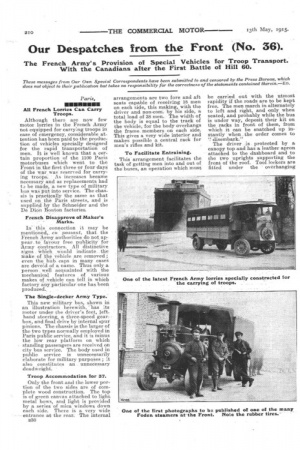Our Despatches from the Front (No. 56).
Page 8

If you've noticed an error in this article please click here to report it so we can fix it.
The French Army's Provision of Special Vehicles for Troop Transport. With the Canadians after the First Battle of Hill 60.
These messages from Our Own Special Correspondents have been submitted to and censored by the Press Bureau, which does not object to their publzcahon but takes no responsibility for the correctness of the statements contained therein.—ED.
Paris, All French Lorries Can Carry Troops.
Although there are now few motor lorries in the French Army not equipped for carrying troops in case of emergency, considerable attention has been paid to the production of vehicles specially designed for the rapid transportation of men. It is well known that a certain proportion of the 1100 Paris motorbuses which went to the Front in the first three or four days of the war, was reserved for carrying troops. As increases became necessary and as replacements had to be made, a. new type of military bus was pUt into service. The chassis is practically the same as that used on. the Paris streets, and is supplied by the Schneider and the De Dion Bouton factories.
French Disapprove of Maker's Marks.
In— this connection it may be mentioned,. enpassant, that the French Army authorities do not appear. tn favour free publicity" for Army contractors. All distinctive signs .which ,Would indicate. the Make of the vehicle are removed ; even the hub. caps in many cases are devoid of a name. Thus only a person : well acquainted with the mechanical features of various makes of vehicle can tell„ in which factory any particular one has been produced.: , The Single-decker Army Type.
This new military bus, shown in an illustration herewith, -has its motor under the driver's feet, lefthand steering, a three-speed gearbox, and final drive by internal spur pinions. The chassis is the larger of the two types normally employed in Paris public service, and it is minus the low rear platform on which standing passengers are received on city bus service. The body used in public, service is unnecessarily elaborate for military purposes ; it also constitutes an unnecessary deadweight.
Troop Accommodation for 37.
Only the front and the lower portion of the two sides are of complete wood construction. The top is of green canvas attached to light metal bows, and light is provided by a series of mica windows down each side. There is a very wide entrance at the rear. The internal
B30
arrangements are two fore and aft seats capable of receiving 18 men on each side, this making, with the driver and non-corn.-by his side, a total load of 38 men. The width of the body is equal to the track of the vehicle, for the body overhangs the frame members on each side. This gives a very wide interior and makes possible a central rack for men's rifles and kit.
To Facilitate Entraining.
This arrangement facilitates the task of getting men into and out of the buses, an operation which must be carried out with the utmost rapidity if the roads are to be kept free. The men march in alternately to left and right, and only when seated, and probably while the bus is under way, deposit their kit on the racks in front of them, from which it can be snatched up instantly when . the order comes to `.` disembark."
The driver _is protected by a canopy top and .has .a leather apron attached to the dashboard and to the two uprights supporting the front of the roof. Tool lockers are fitted under the overhanging






















